Visiting a house can take you to many places. In a way, houses are a portal into someone else and who they are. And sometimes, the opportunity to visit a 16-year-old house built by a National Artist can lead you to discover another artist quietly settled amongst the old houses’ treasures. In the Bahay na Bato Noveau built and designed by National Artist for Architecture, Francisco “Bobby” Mañosa lies the portrait of the Lacson family–a portrait of the current homeowners painted by the award-winning Filipino painter Mia Herbosa-Agoncillo.
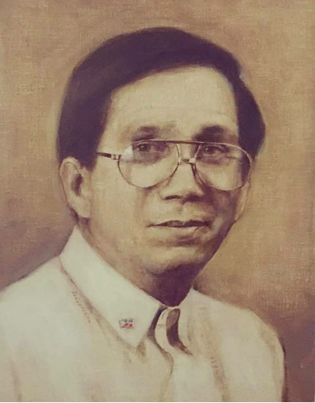
Born Into Art
Herbosa started painting lessons at the tender age of 7. As someone who comes from a family of art lovers (some are painters, some are art collectors) on her maternal side and grew up walking through her grandparents’ homes lined with old master paintings on the walls, this was an expected age when art starts to rear its head and call her forward. Her mother, Elaine Herbosa who is also deeply involved and has been in love with art for the longest time, always encouraged her daughter’s involvement with the discipline.
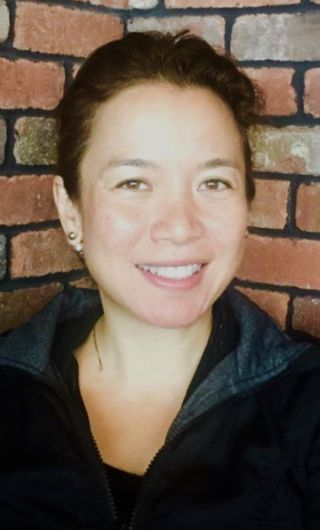
“My mom is also a painter, but she started this in her later years, maybe in her late 50s, sometime after I had started my own career.” Herbosa recalls, “But she is much more energetic and definitely an extrovert, and a people person.”
Currently, Elaine Herbosa has both an art school and a gallery dubbed L’Arc en Ciel where other instructors like the current Miguel Buhay is also present. When she has time and isn’t in New York, Mia Herbosa also gives special one-week workshops on drawing and painting while her mother teaches regular classes like oil painting with still life and kids’ classes. Aside from these classes, mother and daughter have already had several exhibits together.
“We have had very many exhibits together,” Herbosa says, “maybe 2-3 a year now including the annual Art in the Park which she always looks forward to.”
Mia Herbosa’s aunt, Deanna Ongpin was also a Fine Arts History teacher at UP. Through her, Herbosa was able to see the masterpieces at The Louvre as her aunt lived in The City of Lights for a part of her life. It was then that Herbosa was able to see The Mona Lisa, the Winged Nike of Samothrace, and Venus de Milo.
“There was always respect and reverence for art whenever we were around family. It was nice. So I think that was the same summer, that we traveled around Europe looking at paintings with my mom and dad that I began to take a serious interest in developing my own vision and creativity in painting.”
In this new and growing interest, Herbosa had her grand aunt, Doni Ongpin who gave her and her friends, Peachy Juban and Tisha Espiritu lessons in acrylic painting. Herbosa could still recall her lola Doni using the basic subject matter of a fruit bowl with mangoes inside as one of her first exercises as an artist. By the age of 17, Herbosa started seriously doing her own paintings.
Entering The World of Art
Art is a subjective topic. For people, there’s a plethora of definitions that can encapsulate what art really is. For Mia Herbosa who almost seemed destined to have a place in the art world, art is almost like organized chaos and is difficult to define.
Related read: Finding Order Within Chaos: Patrick de Veyra’s Fifth Solo Show
“It is a certain arrangement of elements, that makes one feel something.” Herbosa says, “Many times, it is an organization of things that seems to elevate one’s spirits or takes you out of the ordinary. It reaches for something beyond sometimes with minimal or sometimes extraordinary means. It speaks to our senses–sight, sound, touch, taste, smell–and it enters our hearts and minds, washes over us, and helps us to go beyond ourselves and grow, to be more.”

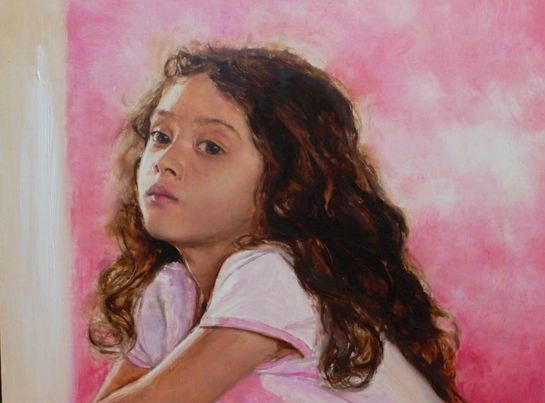
As an artist, Herbosa tries not to judge what she does too much. Plainly enough, she loves that the art she does allows for the constant attempt to be honest and truthful about both the outer world and the inner world.
“I like that it transports me while I do it, and maybe transports others in some way as well.” Herbosa says, “If it doesn’t, well, it was still worth the time to do it for me. I always think if it’s not appreciated now, there is always the future generation that might see my art in full and value it, understanding my life in its entirety. It makes me believe in God really, it is something inside me that teaches me through paint, through colors and lines, and through my hands.”
Related read: World Building with Hiroki Kakinuma
Deeper into Art
Mia Herbosa has been painting for about 31 years–since she was 17 and full-time since she was 22. Back in her college years at Ateneo de Manila, she found mentorship in her fine arts professors like Elaine Navas and Father Rene Javellana who were the voices of support and encouragement who continuously vocalized their faith in her, reminding her that she had a future in art.
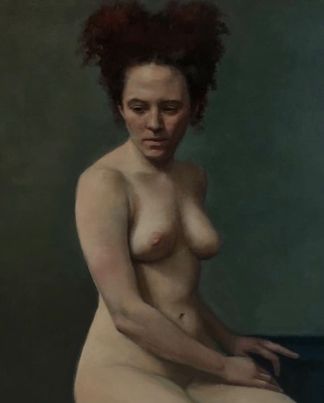
“It was Father Rene who showed me a catalog of the Art Students’ League where he himself studied and where I ended up studying for about two decades of my life learning everything from drawing to sculpture, painting, printmaking, and watercolor to most recently – egg tempera. Almost like a vocation, my path seemed quite clear to me from the very start. At least since I was 17.”
Her paintings have been exhibited both in Manila and abroad including in the U.S., Hong Kong, Italy, and Japan. In the many decades that she’s shown her artworks to different audiences, there have been several favorite reactions to her works, and like every other artist, she finds these gracious compliments towards her art and her as an honor to receive. One constant reaction is people mistaking her paintings to have been done by someone older–a frequent reaction during Herbosa’s younger years.
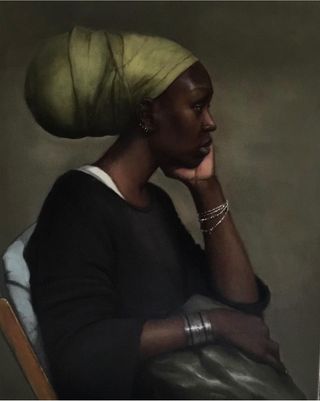
“Everyone was always happy for me that I chose this and that I am able to do it for a living. It always seems to be a surprise that it actually provided a good life for me and my family. It is not very common, I understand. I am blessed that I was able to study under the very best instructors and learn from such a good institution in New York City, The Art Students’ League of New York. I was able to live a dream in a way.”
What’s in the Portrait Featuring Mia Herbosa?
Portraits are artworks that represent a specific individual who’s painted in the way that the artist might meet them in life. They aren’t necessarily just for the sake of recording someone’s features but they are also artworks that portray something about the subject’s character, offering a vivid sense of the real person’s presence. In the West, traditional portraiture extended way back to the times of the ancient Greeks and Romans when lifelike depictions of distinguished people appeared on sculptures and coins.
Here in the Philippines, Damián Domingo y Gabor, Herbosa’s ancestor, was one of the pioneering artists of portraiture and is famously known as ‘The Father of Filipino Art’ who was widely sought after for his miniature portraits and paintings portraying subjects related to religion.
For Mia Herbosa, being related to both Domingo and Rizal induced only a bit of pressure. Her own skills as an artist were never equated to her relations to these historic names either.
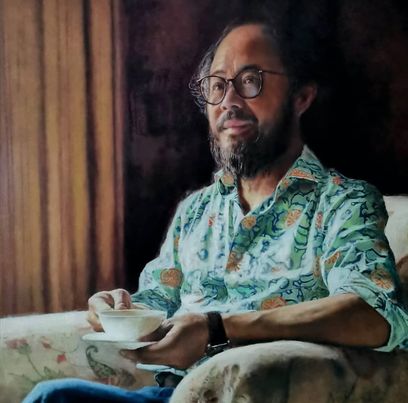
“Being related to Damian Domingo on my mom’s side and Jose Rizal was always of interest to both family trees as well as persons who love history.” Herbosa says, “I do think the talent runs in the bloodline as I have so many relatives, titas, cousins, nephews, and nieces who have great drawing, and painting facilities. And there seems to be an innate sense of taste and design, not only in painting but also in writing, like you. There seems to be a need to express oneself in a certain clear arrangement of things whether it be words or lines, or colors and textures.”
In Herbosa’s paintings, light always seems to be the signature characteristic.
“In whatever I paint, I always am interested in light.” Herbosa says, “I love looking at color as well. I am sensitive to how the color changes with light and how it makes us feel when put side by side with other colors. Colors and lines are living things.”


As expected, Herbosa is a natural-born creator who likes making things, using her hands and eyes to create something new. Aside from the fact that portraiture has always come naturally to her, seeing people enjoy how she portrays them (her subjects) is something she deems a satisfying endeavor for both her and her subject.
“I am always learning about myself with every painting.” she says, “Each painting or portrait is a piece of a jigsaw puzzle that makes up my consciousness and helps me understand what it is I am seeking. I seem to have an inner knowledge of the complexity of life and painting somehow calms me and helps me understand myself and the world in a way.”
Art: A Challenge and A Joy
Many people have seen A.I. making its way through the art world. Some artists scorn it, some are intrigued, and some say that it’s a great tool for artists. Mia Herbosa is one of those artists who aren’t attracted by the idea.
“Since I am a somewhat classical artist and have learned from tradition in a French Atelier style school based in NYC, I tend to not be interested in AI. It doesn’t attract me.” she says, “I don’t think it’s alive. It is fun as a game but I think if people try to make money out of AI by taking advantage of artists and their individual work, I don’t really understand that whole world.”
Though the concept of AI art is an interesting progression in the world of technology, AI cannot replicate the genuine emotions induced and acknowledged by handmade art.
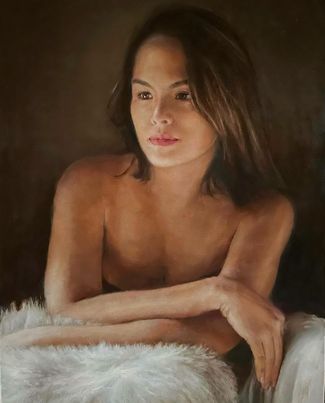
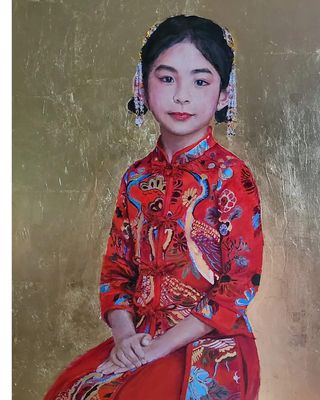
“Everything about it [art] is both a challenge and a joy.” Herbosa says, “I always think that choosing to be an artist in your lifetime is almost like a vocation. You have vows you make with yourself, and for me with God. Surely anyone who does this for the money will have an incredibly hard time. It’s because you put almost everything you have into your work- time, brainwork, labor, love, patience. I always remember Picasso saying that every painting of his was like a vial filled with his blood, sweat, and tears. Your life as an artist is poured into your work. Sometimes, the family has to be very strong to endure this, as well as the artist themselves. It seems like fun, starts out like that but it is so much more. You actually have to pull yourself away from life and dive deep into another world inside you to make art.”
Among the many subjects that immersed her in another life was the Lacson family.
“We [Basti Lacson and she] were carpool mates in Ateneo in college days – a huge carpool which had close to 100 students! He also married my friend, Aina Arcilla.” Herbosa recalled, “A few years ago they got in touch with me to make their family portrait.”
The family portrait for the Lacson family was painted while Lacson’s late wife, Aina started undergoing chemotherapy but was completed after Lacson’s late wife passed. Though Herbosa is already an experienced painter, this portrait was one of the most challenging portraits she has worked on not just for the art technique she had to work through, but also for the emotions she felt alongside the family.
Related read: Curating Memories: Bobby Mañosa’s Bahay na Bato Nouveau
“When you paint someone and their family, you become very close because of the process.” she says, “It took a long time to finish that, maybe 4 to 5 months? They had come to me out of the blue, something which often happens to me…It took me a while to get over that painting once I was done. I was just besieged by worries, and prayed while painting this.”
Portraits aren’t just a profile of the subject. Sometimes, it’s the portrayal of someone reaching a milestone in their life–a birthday, a life change, or a groundbreaking change in life perspective. Either way, Mia Herbosa always finds this line of work one that she’s honored to be in.
“It’s always an honor to accept and understand their needs as well as my need to express truths in paint. It’s like an alchemy of both the sitter and me – combined in the painting. Hopefully producing something that lasts for generations to come.”


